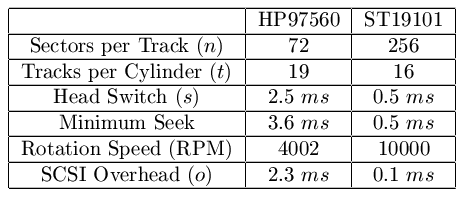
|
Figure 1: Amount of time to locate the first free
sector as a function of the disk utilization. |


|
Figure 1: Amount of time to locate the first free
sector as a function of the disk utilization. |

|
Table 1: Parameters of the HP97560 and the Seagate
ST19101 disks. |
We now extend (1) to cover a single cylinder. We compare the time needed to locate the nearest sector in the current track against the time needed to find one in other tracks in the same cylinder and take the minimum of the two. Therefore the expected latency can be expressed as:

where x is the delay (in units of sectors) experienced to locate the
closest sector in the current track, y is the delay experienced to
locate the closest sector in other tracks in the current cylinder, and
![]() and
and
![]() are the probability functions of x and
y, respectively, under the assumption of a free space percentage of
p. Suppose a head switch costs s and there are t tracks in a
cylinder, then the probability functions can be expressed as:
are the probability functions of x and
y, respectively, under the assumption of a free space percentage of
p. Suppose a head switch costs s and there are t tracks in a
cylinder, then the probability functions can be expressed as:

In other words,
![]() is the probability that there are x occupied
sectors followed by a free sector in the current track, and
is the probability that there are x occupied
sectors followed by a free sector in the current track, and
![]() is
the probability that the first (y-s) rotational positions in all
(t-1) tracks are occupied and there is one free sector at the next
rotational position in at least one of these tracks.
is
the probability that the first (y-s) rotational positions in all
(t-1) tracks are occupied and there is one free sector at the next
rotational position in at least one of these tracks.
Figure 1 validates the model of (2) with a simulation of the HP97560 and the Seagate ST19101 disks whose relevant parameters are detailed in Table 1. The well validated HP97560 model [17, 26] is approximately eight years old. The state-of-art Seagate disk [20, 28] is more complex but its simulator is only a coarse approximation. For example, the model simulates a single density zone while the actual disk has multiple zones. The simulated eager writing algorithm in Figure 1 is not restricted to the current cylinder and always seeks to the nearest sector. The figure shows that the single cylinder model is, in fact, a good approximation for an entire zone. This is because nearby cylinders are not much more likely than the current cylinder to have a free sector at an optimal rotational position and the head switch time is close to the single cylinder seek time.
Compared to the half-rotation delays of 7 ms for the HP and 3 ms for the Seagate that an update-in-place system may incur, Figure 1 promises significant performance improvement, especially at lower utilizations. Indeed, the figure shows that the latency has improved by nearly an order of magnitude on the newer Seagate disk compared to the HP disk. At higher disk utilizations, however, it takes longer to find a nearby free sector. One solution is to compact free space.